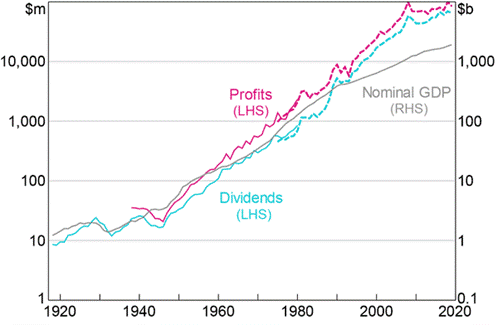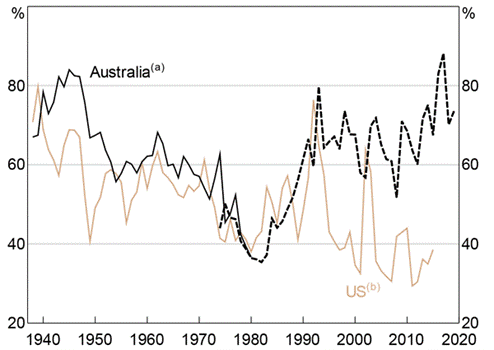
There’s a good reason the S&P/ASX200 has gone nowhere in 16 years.
Yes, to elaborate on the title, there is a good reason as to why the S&P/ASX 200 has gone nowhere in 16 years. As is seen in the table below, from November 2007 to October 2023, there has been no capital gain.
| November 2007: | 6851 points |
| October 2023: | 6853 points |
| Total Capital Gain: | 0.02% |
| Annualised Capital Gain: | 0.00182% |
That’s some result, don’t you think? Sixteen years and no capital gain. And it’s not the first time.
Back in November 2017, in a blog post entitled Active Versus Passive When Prices are Extremely Stretched I asked; “The ASX/S&P200 has gone nowhere in a decade; why invest in the index?”
In September 2017, the S&P/ASX200 index traded at 5672 points, 12 points lower than in December 2006, almost 11 years earlier.
There are many extended periods where the broad Australian index does nothing in terms of capital appreciation, even though, according to S&P Global, the S&P/ASX 200 “is recognised as the institutional investable benchmark in Australia” and “is widely considered Australia’s preeminent benchmark index.” Somewhat disturbingly, it will happen again and again and again.
I want to explain the major contributor to this situation, which won’t change and will continue to provide material for journalists to ponder over for many years and decades. The explanation will also raise questions about investing in an ASX200 ETF and, if the yield is all you receive, whether it is worth the risk – Private Credit funds that we also offer, which have historically offered higher yields and lower volatility, may warrant a look.
Many investors believe the macroeconomic picture determines the performance of Australia’s largest companies, as measured by broader Australian market indices such as the S&P/ASX200 index. Others quite rightly point out that it is company earnings that drive share prices and, therefore, the aggregate earnings of the ASX/S&P200 companies that determine the performance of the index. In truth, it is perhaps a combination of both that variously determines performance over the short and medium term. But earnings and macroeconomics aren’t the whole picture.
What is missing is dividends.
The above references to poor long-term performance only look at the capital gain and therefore confirm that all of the returns investors have made from investing in the S&P/ASX200 over the last 16 years have come from dividends, either taken as cash or reinvested into the same index that has gone nowhere. It is the compounding of dividends upon dividends that explains the only return investors have received.
That fits with the payout policies of Australian companies, driven as they are by our taxation system, which produces franking credits that have no value to a company and enormous value to those on lower personal tax rates than the company tax rate.
Let me break it down.
The mechanics are simple. If a company has $100 of equity, generates a sustainable 20 per cent return on equity and pays out none of those earnings as a dividend, that company’s earnings will grow at 20 per cent per annum. The earnings growth rate always equals the rate of return on equity (ROE) if the payout ratio is zero.
If the same company pays out 100 per cent of its earnings as a dividend, no money will be retained as additional equity for the next year, and therefore, the company will earn the same 20 per cent on the same equity as last year. And therefore, earnings won’t grow at all.
If I start a business with $100 of equity and generate a 20 per cent return on that equity each year – which is $20 of earnings – and I then pay out that $20 each year, then my equity will stay at $100 every year, and my earnings will stay at $20 per year and won’t grow.
Putting aside changes in the popularity of stocks, which is reflected in the price-earnings (P/E) ratio, the only way I can sustainably grow the share price of my hypothetical company is if I grow the earnings. But if I pay out all the earnings as a dividend each year, and the return on equity remains the same, the earnings will also stay the same, and so will the share price.
I must grow the earnings to grow the share price. If the earnings don’t grow because I pay out as much as possible in dividends, the share price won’t grow either.
This is happening in aggregate at Australia’s biggest 200 companies and is why the index is not going anywhere. Before Covid-19, the average dividend payout ratio of S&P/ASX 200 companies was 72 per cent. That means 72 per cent of all company earnings are paid out as a dividend rather than retained and compounded to grow their earnings in the future.
As Figure 1., and Figure 2., reveal, a very high proportion of Australian company earnings are paid out as dividends.
Figure 1. Listed companies’ profits and dividends (Top 100 companies by market capitalisation, log scale)

Source: Thomas Mathews, RBA, June 2019[1]
Figure 2. Dividend payout ratio

Source: Thomas Mathews, RBA, June 2019[2]
And why is the payout ratio persistently so high in Australia (and compared to the U.S.)? It’s all to do with tax and franking credits.
To avoid the double taxation of dividends in Australia – at both the company level and at the recipient level – franking credits are attached to dividends to the extent that corporate tax has been paid on a company’s profits. These franking credits are equivalent to additional cash for dividend recipients whose tax rate is lower than the corporate tax rate. But these franking credits are of zero value to a company.
The result? Australian companies tend to pay out the franked dividends to make their super fund and retiree shareholders happier. Of course, shareholders would be better off if a company earning a high rate of return on equity kept the dividends and reinvested them. Even after discounted capital gains tax and franking credits are considered, the investor who insists their company retain profits at 20 per cent rates of ROE will be far better off than if they take the dividend.
Warren Buffett’s Berkshire Hathaway is a prized example of this decision in action. Berkshire has generated circa 20 per cent ROE for over 50 years and never paid a dividend. Most income investors would be aghast. But the result is that the equity grows each year by 20 per cent, and as long as the ROE stays at 20 per cent, the earnings also grow by 20 per cent per annum. That’s why Berkshire’s share price today is U.S.$512,000 per share. If an investor needs some income, they can sell a share. And if they want a really entertaining year, they can sell two!
If Warren and Charlie can generate 20 per cent per year on your shareholder money, why would you want them to pay it out to you? The best you might do is five per cent in a term deposit. It’s smarter to let Warren and Charlie keep the money and earn 20 per cent a year for you.
I explain how the math works in this blog post entitled: If You Are an Income Investor It Pays to Think Long Term.
For investors in the broad Australian stock market index, the other problem, of course, is that the average return on equity isn’t 20 per cent. Many of the businesses are mature, and they already dominate their market, so they have few places to reinvest their earnings for growth.
Indeed, if a company cannot earn a rate of return on its equity better than you can generate elsewhere, its board should pay out its earnings to you as a dividend. If they don’t, you are worse off. For example, suppose a company can only generate a five per cent return on equity, which is the same as you can achieve in a Term Deposit at the time of writing. In that case, you are better off taking the dividends as cash and reinvesting in the Term Deposit because it has lower risk. In fact, in that example, you might want to ask why you are invested in that company at all. Some companies listed in Australia need to retain profits, not because they want to grow, but because they need to reinvest just to stay in the same competitive position and to stop them from going backwards. That’s the worst treadmill to be on and a company you don’t want to own.
Of course, when you invest in an index like the S&P/ASX200, you don’t have a choice about which companies you invest in, so you will inevitably be holding these cash burners too (think Telstra and look at its share price performance over 20 years!).
News that the S&P/ASX 200 is trading where it was 16 years ago does not surprise your author. Thanks to our system of franking credits, our companies will be incentivised to keep paying out most of their earnings as a dividend. Go back to Figure 2. and look at Australia’s dividend payout ratio versus the U.S. payout ratio. With more profits retained for growth, it should be no surprise the U.S. market, as measured by the S&P500, has, and will continue to, outperform the Aussie equivalent. And that certainly raises questions about which index ETF you should not invest in.
When dividends are high, capital gains are low.
The only exception is when a company can pay all its earnings out as a dividend and expand its Return on Equity.
For investors in Australian companies, the onus is on you to find better businesses, big or small (those generating high rates of return on equity and are simultaneously able to reinvest large portions of their profits) in which to reinvest your dividends, ensuring you grow your wealth and maintain your purchasing power. Or find an active fund manager who can do that for you.
You can always buy more shares in the company with your dividends and your franking credits if you wish to, or keep what you need to live on.
That’s right Richard. And if the price is lower than the intrinsic value, you are also getting a good deal. But that is rare.